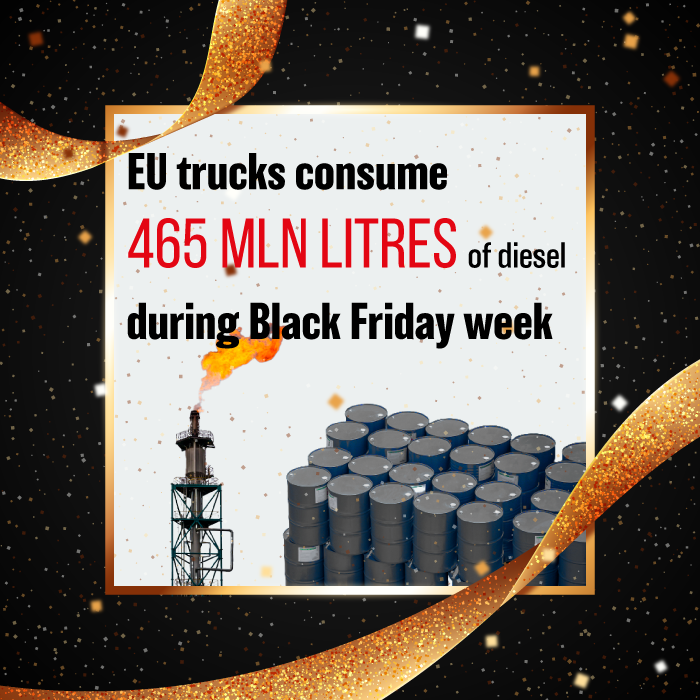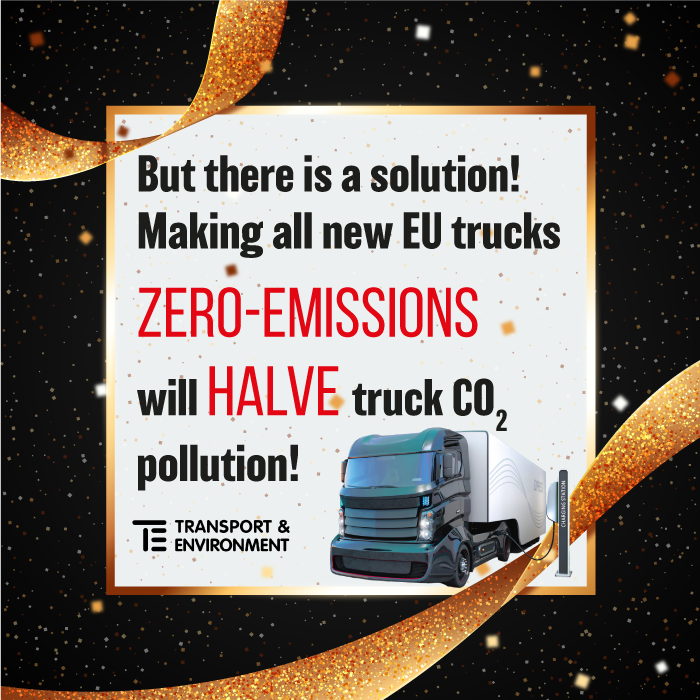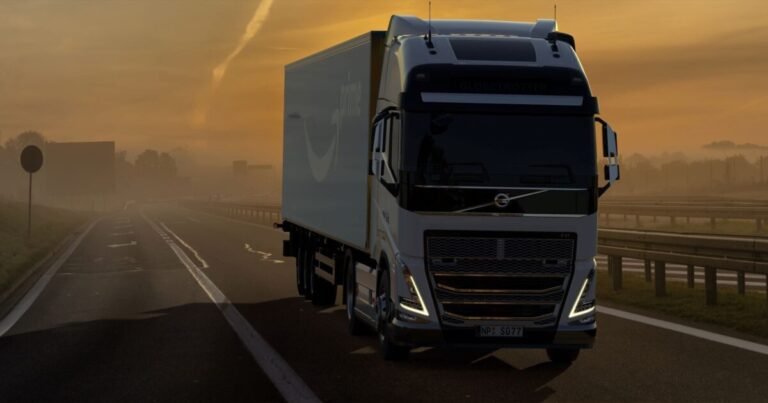Black Friday is notorious for its high levels of consumption and waste. But the real cost of the headline-grabbing discounts is also paid in the climate impact of hauling all that extra freight on our roads. Trucking retail goods is a dirty business, and it sees a huge spike around Black Friday. That’s frustrating because there’s a ready-made solution to reducing the climate impact of trucks—if regulators would just send the right signal to truck manufacturers to start using them.
To quantify the impact of truck pollution on Black Friday, T&E analyzed historical sales data to estimate the additional demand generated by Black Friday. We then converted that to truck activity and calculated the associated emissions.(1) The results dramatically highlight the huge climate impact that trucks have, not just during Black Friday week, but every week.
During the week of Black Friday this year, 1.2 million tonnes of CO2 will be released into the air by trucks transporting our parcels to warehouses and stores across Europe. That’s almost 600,000 extra tonnes, or around 94% more than the average week.
Trucks will race across the continent to make sure physical and online stores meet consumer demand.(2) The additional pollution in one week is equivalent to the annual emissions of all the trucks in Bulgaria, or about 3,500 round trips from Paris to New York(3).
Trucks are the main means of transporting goods in Europe, accounting for 64% of freight transport emissions(4). Their activity is expected to grow sharply in the coming decades(5). At the moment, almost all of them run on polluting diesel, which is bad for the climate and the environment.
But it doesn’t have to be this way. There is a ready-made solution to the problem of road freight pollution in the form of zero-emission trucks. These vehicles are available on the market today, and by 2035, almost all new electric trucks—including long-haul trucks—will cost less to own and operate than their diesel counterparts, while still being able to travel long distances and carry large amounts of cargo. Trucking companies shouldn’t compromise on the fact that electric trucks will match diesel in cost and capability.


Some big truck buyers are already making the switch. Amazon just announced it will add more than 1,500 electric heavy-duty trucks to its European fleet over the next five years, and Deutsche Post DHL says it will buy 44 new electric trucks. But with electric trucks accounting for less than 1% of new rigs sold, progress toward zero-emission trucking is painfully slow.
But that’s not necessary, as EU regulators prepare to step in by tightening climate targets for heavy vehicles. The only question now is how ambitious the EU can be in reaching zero. Anything beyond the 2035 deadline for ending sales of new motorized trucks would condemn the bloc to failing to meet its goal of achieving economy-wide net zero emissions by 2050.


If the EU adopted a phase-out date of 2035, it would already be possible to achieve an 11% reduction in CO2 emissions from trucks by 2030, and a 48% reduction by 2035 (compared to 2022). This means that Black Friday emissions from trucks would also fall by more than 10% already in 2030 and almost halve in 2035. Allowing the sale of polluting trucks at any point after 2035 would result in many diesel trucks still on our roads by mid-century. We can say goodbye to net zero and hello to a hotter, messier world that even “retail therapy” won’t make any better.
(1) A methodological note with a detailed explanation is available for download.
(2) Note that this analysis does not count emissions from delivery trucks making home deliveries during Black Friday, but only the physical stores and warehouses where the delivery trucks depart.
(3) Emissions for the entire aircraft (Boeing 777-300ER) assuming it is operating at full capacity.
(4) Calculations based on UNFCCC data, available here https://di.unfccc.int/time_series
(5) An increase of 44% between 2020 and 2050, according to the EU reference scenario.
https://energy.ec.europa.eu/data-and-analysis/energy-modelling/eu-reference-scenario-2020_ar&sa=D&source=docs&ust=1668761161206041&usg=AOvVaw39qzA0Kz0CNz_tuR2nh8ls





